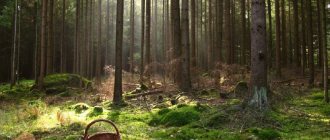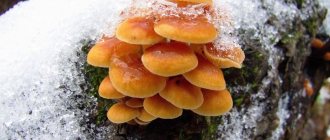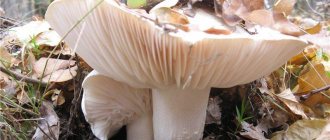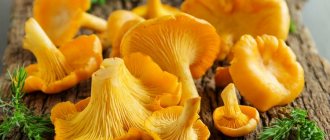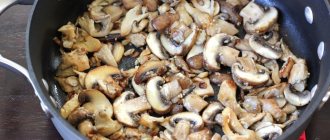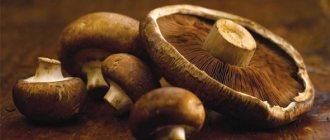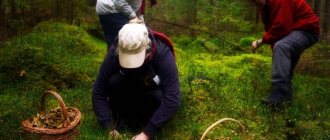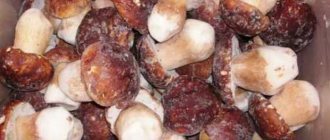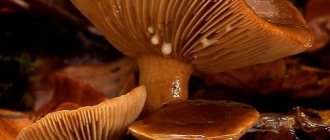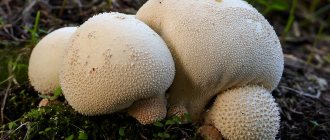White mushroom picking 2022
It is impossible to accurately determine the growth cycle of this fungus, if only because it depends on the specific area and its characteristics. In general, we can only say that their fruiting begins at the end of the summer - at the beginning of summer. The end of the harvesting season for this mushroom occurs at the end of autumn. If we talk about the northern regions, then the rush for white mushroom there begins in June and ends in September.
When choosing a specific area for picking mushrooms, you should stop in deciduous forests and mixed forests.
It is worth looking for porcini mushrooms under fir, pine and birch trees, as well as spruce and oak trees. They are also found under hornbeams, in areas where lichen and moss thrive, and where the soil is predominantly loamy or sandy loam. Suitable for growing porcini mushroom and swamps, as well as peat bogs.
It is known that this trophy is more often found in well-lit places, but it will also develop in a darkened clearing, so you should not exclude them in advance. But ignore, in order not to waste time, preferably areas with highly moist soil. White ones are a real rarity not in the forest-steppe, steppe, forest-tundra; such mushrooms cannot be found in the tundra either.
Secrets of quiet hunting: looking for mushrooms and berries
photo: Fotolia.com
SO THAT THE GOGGER DOESN’T “BYPASS”
My neighbor and I went out early to pick mushrooms. We walked along the short road that led past the well. However, before they had time to leave the outskirts, the neighbor suddenly stopped and said: “You see, Markovna is hobbling towards the well with empty buckets. We need to get around it. Otherwise, don’t expect mushroom luck.”
Mushroom pickers, like fishermen and hunters, are superstitious people. Both before going to the forest and while picking mushrooms, they notice everything that can affect the outcome of the mushroom hunt. And often failure is attributed not so much to one’s own inexperience, inattention, or sluggishness, but to secondary reasons: bad luck, the bad influence of other people.
“A happy person should go pick mushrooms, an unlucky person should wander through the forest,” say experienced mushroom pickers, believing that a person with a bad character and gloomy thoughts has nothing to do in the forest. If you are not in the mood and your head is busy with restless thoughts, then not only will you not find mushrooms, but you will also end up getting lost and getting lost in the wilds of the forest.
Here, however, the following advice from knowledgeable mushroom experts can help. If an inexperienced mushroom picker gets lost in the forest, it means that a devil has bypassed him. You need to take off all your existing clothes and put them on inside out.
It is also advisable to take off your shoes and turn over the insoles in your boots. The goblin will then retreat and it will be possible to calmly find the way back. “Eat the mushroom pie and keep your mouth shut,” the father instructs his son over dinner, passing on the secrets of mushroom hunting.
Opening them right and left, boasting excessively about forest trophies, chatting too much about mushroom places is an obscene, wasteful thing for a real mushroom picker, which does not honor him, and can also negatively affect his mushroom success.
It is considered a bad omen when leaving the house to meet a neighbor who asks: “Where are you going?” In this case, it is advisable not to tell him about the purpose of going to the forest, but to answer: “Well, I’m going to take a walk, get some fresh air.” Which, by the way, will be true.
Good equipment is very important for hiking in the forest. First of all, you need to take care of your shoes. “Whoever goes into the forest barefoot will come across only old mushrooms,” say mushroom pickers. Not just barefoot, but even in flimsy light shoes or boots, through the holes in which the heels glow, you can’t walk through the forest.
Success while picking mushrooms depends on how you enter the forest, what your first steps will be, what words you utter. The forest is the same temple. And, as you know, they enter it with a bow and prayer.
Let’s say this: “I’m going into the forest, tick, don’t climb into the forest, but snake, for the sake of it, crawl under the block.” Such spells used to be natural and familiar for mushroom pickers and berry pickers. Like, for example, such actions.
In order to more successfully find mushrooms and berries, when entering the forest you need to stick small branches from three different trees into your hat or scarf, and put three different blades of grass in your pocket.
For a mushroom picker, it is important to immediately enter the forest, find a mushroom and carefully put it in the basket. The initiative is more expensive than anything else. For example, for his sake, sometimes I leave a couple of mushrooms at the edge of the forest, which I cut off the next day. These first russulas at the bottom of the basket immediately lift your spirits, promising good luck in your future searches.
| photo: Fotolia.com |
Among mushroom pickers, however, there is an opinion that some mushrooms can be easily jinxed. I touched the mushroom or even looked at it, and the mushroom no longer grows, it begins to wrinkle, wither and wither. It is hardly worth taking this superstition seriously.
In any case, the next day I found the left mushrooms always fresh, clean, and some even slightly grown. In the old days, the first mushrooms were placed in hollow trees. To ensure good luck during mushroom hunting, at the first thunder, they rolled or somersaulted on the grass.
Mushrooms can be targeted by forest animals. For example, a hare. It was believed that if a hare jumped out from under your feet while picking mushrooms, then you need to go in the direction where it ran, since this animal usually runs to mushroom places. However, before you step on the hare's trail, you need to pick up the first object you come across from the ground and throw it over that trail.
MUSHROOM CONVERSATION... HAIR TO HEART
I didn’t hear how an elderly mushroom picker quietly approached me, as if sneaking up. He looked into my basket, at the bottom of which there was a lonely yellow handful of honey mushrooms, and said:
– You need to talk to mushrooms. Have a heart-to-heart talk. Then the mushroom will show the way to another mushroom...
He said and disappeared among the gray trunks. “Some kind of mysticism,” I thought and continued my mushroom search. It was winter, during an unexpected thaw. Mushrooms—winter honey mushrooms—were rare. I noticed the edge of a yellow cap under the bark. “Where are you, my friend, hiding? – I whispered, picking out the fungus. “Where are your relatives?”
After examining the trunk, I found several more fungi. Approaching the next stump or willow tree, I mentally turned to the mushrooms that could grow there. And just imagine, honey mushrooms began to appear, although not as often as dreamed, but with a consistency that made the mushroom walk especially enjoyable.
I searched for a long time near a spreading dry poplar. Unsuccessfully. No matter how much I talked to the mushrooms, no matter how much I begged them to show themselves to me, the search was fruitless. And suddenly a quiet voice was heard, almost a whisper:
"Look up." I raised my head and saw a yellow chain of honey mushrooms climbing between the branches to the top. The walk through the forest turned out to be quite rewarding. Thanks to the mushroom hunter for the tip.
Antoshka stands on one leg: whoever doesn’t pass by bows to everyone. Bow to the mushroom or bow to the man?
Since ancient times, mushrooms have been animated; they were even considered creatures that were capable of thinking and perceiving human thoughts.
In Chukotka, for example, archaeologists found images of humanoid fly agarics among rock paintings. Some mushrooms were even attributed to divine origin. One of the German herbalists of the 16th century said about them: “Mushrooms are called children of the gods, because they are born without seeds, not like others.”
Old mushroom pickers know many signs that involuntarily make a person related to mushrooms. It’s good, for example, to constantly keep mushrooms in your imagination while wandering through the forest. They say that this method is very helpful in searching for a particular species.
There is also an opinion among mushroom pickers that mushrooms grow best in places that are attractive to humans.
Once in the Carpathians we spent a long time choosing a place to stay for the night. Finally we found a very cozy clearing in the forest under a spreading beech tree. We quickly prepared a meager dinner from leftover food and went to bed. And in the morning it turned out that the area was full of mushrooms. And russula, and white hornbeams, and local hornbeams.
BOTH BREADWIRES AND DOCTORS
Once my son injured his finger in the forest. I immediately remembered my grandmother’s advice and, having picked an overripe puffball mushroom, which is popularly called “flutter mushroom,” I sprinkled brown-green pollen on the cut, pressing the velvety skin on top. “It will heal before the wedding!” – I patted the guy on the shoulder, and my son walked happily along the path further.
Since ancient times, mushrooms in forest areas have been not only breadwinners, but also healers.
Each mushroom has its own place in the kitchen and its own medicinal purpose. It is popularly believed that some types of mushrooms protect against cancer. Boletus mushrooms are primarily classified as “anti-cancer” mushrooms.
By the way, they contain the alkaloid herzenin, a tonic that stimulates the activity of the cardiovascular system. Winter honey fungus contains flatulin, a substance that delays the development of such a dangerous disease as sarcoma. Flatulin, in addition, is a good protective agent against sore throat.
The development of cancer cells is stopped by the satanic mushroom and chaga (birch mushroom). Chaga in general is a significant mushroom in medicinal practice. It increases the body's defense reactions, activates tissue metabolism, and lowers blood pressure.
| photo: Fotolia.com |
Preparations from it - tincture and extract "Befungin" - are used to treat gastritis, stomach ulcers and gastrointestinal tract. To this day, chaga tea is popular among fishermen, hunters, and rural residents. Oyster mushroom also has antitumor activity.
It protects against diseases most often caused by improper, too mealy or fatty diets. Doctors recommend oyster mushroom to eliminate the danger of atherosclerosis and thrombophlebitis. This mushroom is also valuable because it protects people from environmentally harmful substances by removing heavy metals and radionuclides from the body.
Chanterelles are also immune to them. They, as it turns out, can be processed into medications that can protect humans from radiation. By the way, chanterelles contain the most vitamin A, which is of great importance for the human body, especially during the growth period.
Mushrooms have long been used to treat wounds, cuts, ulcers, and frostbite. Many rural residents still use raincoats to heal abrasions. The same bactericidal properties are possessed by porcini mushroom, saffron milk cap, common mushroom, and common vesel. Active antibiotics are yellow bramble and blue milk mushroom.
Extracts from these mushrooms cure sore throats. The growth of pathogenic bacteria is retarded by violet row and summer honey fungus. Frostbite is successfully treated with boletus mushrooms.
To do this, you need to dry the porcini mushrooms and, after boiling them in their own juice, obtain an extract, which, after slightly warming up, is used to lubricate frostbitten areas of the body. Extracts and extracts from champignon help typhoid patients with purulent wounds. Purulent inflammations are also successfully treated with bitterberry preparations.
The tenth route is taken by mushroom pickers with red fly agaric caps. However, among some peoples this mushroom is held in special esteem.
Here is some piquant detail about the drinking customs of the Kamchatka aborigines reported by one past traveler: “Sometimes instead of vodka, the Kamchadals use fly agaric, a well-known mushroom that we usually use to kill flies. It is soaked in fireweed wort and then they drink this wort or swallow whole dried mushrooms rolled into a tube.”
If fly agaric wort knocked healthy people off their feet, then “fly agaric alcohol,” which has long been considered among the Slavs as an effective remedy against radiculitis and rheumatic pain, on the contrary, brought the poor fellows crippled by illness back to their feet. What was this alcohol and how was it extracted?
The fly agaric mushrooms were placed in a closed container in a warm place and after a while they released juice. This was “fly agaric alcohol.” In some areas, alcoholic infusions were made from both dried and fresh mushrooms. Polesie Belarusians baked a bottle of fly agarics filled with vodka in a bread loaf.
Poleshchuks also used fly agarics internally - in powder form for malaria. Today's medicine has established that fly agaric ointment is a highly effective remedy for radiation damage to the skin and mucous membranes.
Preparations from these mushrooms have also proven themselves in the treatment of allergic skin diseases. In France, a sleeping pill is prepared from the red fly agaric.
In the treatment of tuberculosis, drugs obtained from pepper milk mushrooms, giant talkers, and some types of rowing are useful. The tuberculosis bacillus is also suppressed by saffron milk cap.
It contains antibiotics that are fatal to Koch bacilli and E. coli, which cause diarrhea.
In the fight against E. coli, staphylococcus, and some harmful bacteria, honey fungus is active, which has a tonic effect on humans.
And autumn honey fungus is quite suitable as a mild laxative. The skillful use of gray dung beetle causes an aversion to alcoholic potion. A resinous substance obtained from larch oil helps relieve headaches.
Preparations from gall fungus improve liver function. And truffle can generally rejuvenate the body. No wonder the ancients loved him so much.
Vladimir Suprunenko August 4, 2022 at 12:12
In Moscow and Moscow region
It is not advisable to “hunt” for white mushroom within the city limits due to the high risk of collecting trophies that have accumulated many toxic compounds. It’s better to go in search of:
- to the territory of the Ruza district, famous for its ecological cleanliness (focus your attention on Novovolkovo and Oreshek);
- to the Stupinsky district, where you can get by train from the station. Paveletsky (go towards Zhilevo or Shugarovo);
- and the Yegoryevsky district, where it is advisable to comb the surroundings of Vareika, Savvino, Bolshoi Gridin, as well as the village of Kostino.
Why do modern people need mushrooms? After all, there is enough food, there is no vital need to collect tops and roots in the forest and in the field... Moreover, this pleasant activity is not so safe.
Mushroom poisoning can be fatal. Why do people love mushrooms so much, and what needs to be done to prevent this hobby from harming their health?
Mikhail Vishnevsky
Russian fun
— Mikhail Vladimirovich, why do you think many people, despite the danger, collect mushrooms?
— Russia, as they say in science, is a mycophilic country, that is, mushroom-loving. And there are countries where mushrooms are perceived as evil. Historically, we treat mushrooms with reverence. Russia has been mycophilic for half a millennium, if not more. And only one or two generations have grown up since then, when the whole family went for mushrooms - just like food. That is, the first reason for love is historical and cultural traditions. All hunters and fishermen are also mushroom pickers, and we also have a lot of them. From an economic point of view, mushroom picking is also justified.
If you remember, during perestroika, people went into the forest en masse for free food. True, the peak of mushroom poisoning occurred precisely in the early 90s... For many, mushroom picking is a form of outdoor recreation, relaxation. In addition, for several centuries, mushrooms in Russia were consumed no less than 200 days a year - during fasting, as the main lean food, a meat substitute. And how can the tradition of mushroom picking not arise here?
— Many people also say that they love mushrooms as a product.
- Yes, mushrooms are also delicious. And although it is almost useless food for us, mushrooms are a powerful attractant. That is, they contain a number of substances that are very attractive to our body from a nutritional point of view. Even people who have never tried mushrooms before can feel an uncontrollable craving for them the first time. They have the so-called “fifth taste,” “umami,” which was discovered by the Japanese about thirty years ago. It is found in seafood, seaweed and fried mushrooms, among others.
We take the known
— What “safety precautions” exist for collecting edible and identifying poisonous mushrooms? What should a person remember when going into the forest?
— Unfortunately, this topic is as endless as it is meaningless. There are a huge number of myths, direct and at the same time completely incorrect instructions and recommendations. For example, determine the edibility of mushrooms using onions, garlic, or a silver spoon. For some, onions turn blue in a saucepan with “poisonous” mushrooms, for others, garlic, for others, silver spoons turn black...
- And all this is nonsense?
- Definitely! But it is not unique to us - among Americans, for example, rice turns red... That is, there are many different misconceptions. Color and other reactions - both edible and poisonous mushrooms can produce them, it depends only on their biochemical composition. Therefore, you should never pay attention to any culinary “signs” and take them seriously. In the forest you need to follow one simple rule that always works: take into the basket only what you know well. And if you decide to master some new types of mushrooms, then it’s better to go on excursions to the forest with me! (Laughs.) Or with another experienced and preferably local mushroom picker.
Because no picture from the Internet will convey the real feeling of a mushroom when you pick it yourself, you see how young, and mature, and old it is, what happens to the pulp when cut: does it change color or not... If you take all those who were poisoned, then basically these are either beginners who have just gone out into the forest and are sweeping everything, or just more or less experienced, advanced mushroom pickers who have already believed in their abilities and begin to put things in the basket that they think they need familiar. But sometimes they are fatally mistaken.
— You said that it is better to take a local mushroom picker as a travel companion. Why?
- Yes, if you are not interested in chanterelles, boletus, boletuses, which cannot be confused with anything, but want something new - something that grows in this particular area - you need a local mushroom picker. It is very dangerous to pick mushrooms if you come to visit or go on vacation to another region, and especially to another continent. Because many classic edible mushrooms in one place have almost indistinguishable deadly counterparts in other geographical or climatic zones.
Honey mushrooms are coming again
— Now mushroom lovers are waiting for the appearance of autumn mushrooms. What poisonous mushrooms can “join”? Are any of them deadly?
- Unfortunately, there is. Of the really deadly mushrooms - if we take the central part of Russia - this is the toadstool, but it has already moved away, it is already too cold for it. But the stinking fly agaric continues to grow - it is a complete analogue of the pale toadstool, its close relative, it is pure white in color, it is confused with forest champignons. Here it will grow throughout October. Therefore, when collecting wild mushrooms, you need to continue to remain vigilant. As for honey mushrooms... About twenty years ago, the deadly poisonous grebe began to increase in number in our country; it doesn’t even have a Russian name - fringed galerina. It grows from the beginning of summer and practically goes into winter. It is usually confused with the summer honey mushroom. But it can - and more likely by accident - end up in the basket along with the autumn honey mushrooms.
Autumn honey mushrooms are different from it: they are large, light, honey-colored, fat, large, and galerina is a small, slender, dark brown fungus. But she has one vile property. If normal honey mushrooms - be it summer, autumn or winter - grow in bunches, from one point, then galerina grows singly. Each fungus comes from its own point. On the one hand, this is a good distinctive feature. But it is precisely thanks to this quality that one or two mushrooms can poke out between bunches of normal mushrooms. And a person simply won’t notice them and cut them off along with the rest. Therefore, the key task of a mushroom picker is to collect mushrooms calmly and carefully.
- How dangerous is this mushroom?
— The lethal dose for an adult is approximately 20 mushrooms. Galerina contains the same poisons as the toadstool, and in greater concentration. When the winter honey fungus begins, vigilance needs to be increased, because the galerina will happily grow on the same stump with it. And it is really similar to the winter honey mushroom due to its thin brown leg.
— Are there statistics on deaths from mushroom poisoning?
— It exists, but it’s not very reliable; Statistics are not available for all regions. Globally, this problem has not yet been addressed across the country. Perhaps in ten years we will come to some kind of denominator. But so far the following figures have been announced: on average across the country, from several tens to one and a half thousand fatal mushroom poisonings occur annually. The maximum occurs in the south of the European part, the Volga region. Because there most often the pale toadstool is confused with green russula and greenfinches.
To cook or not to cook?
— What rules must be followed when preparing mushrooms?
“In my books I talk about this in detail. I have separate reference books on mushrooms, there are books on cooking, where I talk about different mushrooms and methods of preparing them, preparations. Naturally, each mushroom requires its own approach. I’ll say right away: there’s no point in boiling a single mushroom for two hours, as “experienced” mushroom pickers sometimes advise. Even those mushrooms that really require boiling. If the mushroom for some reason, and there are very few of them, requires preliminary boiling, then it should be cooked for 15 minutes, no longer.
There are people who cook for an hour several times, draining the water each time - naturally, at the end they get a tasteless rag, odorless and without the desired consistency. I don’t understand how this exists. It is customary to boil mushrooms only in three cases. If it is a mildly poisonous mushroom, which after boiling will become edible. If it is a bitter or pungent mushroom, its unpleasant taste will disappear after boiling. Or if you doubt the environmental cleanliness of the place where the mushroom was picked.
— Are the weakly poisonous ones what are called conditionally edible?
— Conditionally edible is an abstract term, outdated and does not mean anything. He only scares people with his ambiguity. Definitely edible - that's understandable. What about conditionally? What are these conditions? Are they followed? And will they work on me? Nobody knows... It's like mushroom categories: first, second, third, fourth. This is also a completely meaningless thing in our time, which came from Rospotrebkooperatsiya and is actually intended as a classification of the convenience of harvesting and transporting mushrooms in combination with their nutritional value.
This scheme does not reflect the real culinary value of the mushroom and does not distinguish between old and young mushrooms. So, if the mushrooms are collected in a clean forest, then we boil them only in two cases. First: make a mildly poisonous mushroom non-poisonous - that is, destroy the poison. It’s like in the case of Stochka or the red fly agaric: I boiled the mushrooms, drained the broth, and got an edible mushroom. Or to remove an unpleasant taste or smell. For example, I boiled bitter russula - and it became normal: sweet, pleasant. There are special cases - for example, if a person has problems with the gastrointestinal tract, he is very sensitive to coarse fibrous ballast food. Then it makes sense to boil autumn mushrooms before frying them.
- So, in this way we will help digestion a little?
- Like that. The third case when boiling mushrooms is required is if it is not possible to get out into a normal forest and you collected mushrooms in a forest or park near the city. Or even mushrooms at home. Or even porcini mushrooms, chanterelles or aspen mushrooms that you bought from your grandmother on the highway. You don’t know where grandma collected them! What if along this route?
And although this is blasphemy, even such boletus mushrooms will need to be boiled if you are worried about your health. They could have absorbed xenobiotics - that is, foreign, non-natural pollutants, and it is necessary to make sure that they come out of them. These are the cases when it makes sense to boil mushrooms. In all other cases, mushrooms are cooked only if the recipe requires it. It is clear that they are boiled in the soup.
For the long winter
— Harvesting mushrooms for the winter - what mistakes can there be? And can you get poisoned from canned mushrooms?
— Poisoning can happen for two reasons. The first is inattention when you prepare a poisonous mushroom.
— That is, the poison does not break down over time?
— There is a myth that if you cook poisonous mushrooms for a long time (and also add a lot of salt and vinegar), they will no longer be poisonous. So, the longest experiment on boiling toadstool lasted two and a half years! And everything that was poisonous in it remained in it! Mushroom poisons have two main characteristics that determine the ability to remove toxicity during home cooking: they can be heat-stable or heat-labile (that is, not destroyed at a temperature of 100 degrees - or destroyed).
And the second property is the water solubility or water insolubility of poisons. That is, when boiling, the poison either remains in the mushroom or comes out into the broth. Unfortunately, in the toadstool, they are not destroyed at 100 degrees, and do not form a decoction, but remain in the mushroom. And in strings, the poisons are not destroyed at 100 degrees, but they are water-soluble, and after boiling they come out in a decoction. Therefore, you cannot cook soup from strings, but boiled and then fried strings are no longer poisonous.
— That is, if a mushroom with non-destructible poison gets into the product, the entire batch of canned food will be poisonous?
- Yes, and then, at best, there will be many health problems... So, the first mistake is inattention when collecting and preparing mushrooms for canning. The second mistake is non-compliance with technology. The main threat here is botulism. Of all cases of botulism in the country, two thirds are caused by mushrooms. And this happens primarily due to the fact that the mushrooms are poorly prepared for preservation: they are not washed very thoroughly. Botulinum bacteria always come from the ground, which remains on the legs, sometimes on the caps. Therefore, thorough washing is absolutely necessary. I understand that this is difficult to achieve if you need to wash a whole bath of mushrooms, and it’s already four in the morning and you only want one thing: to finish it all as quickly as possible! (Laughs.)
— How to freeze mushrooms correctly?
— Freezing is an excellent method of preparation. It is better to freeze fresh mushrooms, even unwashed ones - the kind you brought from the forest. It is enough to wipe young and strong mushrooms with a damp cloth and freeze them in this form. This method is also good because the mushrooms retain their appearance and shape, but the water inside their cells crystallizes and the cell membranes are destroyed. This is how we get the most nutritious product possible.
Otherwise, mushrooms are practically just tasty ballast. After all, a mushroom cell consists of chitin - this is the main “composition” of the shell of crayfish or insects, and the human stomach is not able to digest chitin. Pre-freezing helps with this. But there are also mushrooms that need to be boiled before freezing. And surprisingly, these are chanterelles. If you freeze them fresh, most likely they will taste bitter after defrosting. And if you boil them at least a little first, they will retain their taste.
— Are there any foods that are strictly not recommended to be eaten with mushrooms? Milk, for example?
— It all depends on how the mushrooms are cooked. If these are salted or pickled mushrooms, then milk, of course, is undesirable... But mushrooms go well with various cereals, flour products, pasta, and so on. With fried potatoes too - no one has canceled the classics! Salted and pickled mushrooms are good served with bitter strong drinks. Stewed mushrooms and mushrooms in all sorts of sauces go with red and white wines.
Mushrooms themselves are strong components of dishes. So they will go with anything. If they are boiled, they are even added to salads with seafood... That is, perhaps, it is difficult to name a product with which mushrooms cannot be “made friends” - unless it is some kind of sweets... Although there are exceptions here too. For example, jam is made from the same chanterelles, and candied fruits are made from butter and oyster mushroom legs. Mushrooms are a universal product. And for this, too, they are worth loving.
Larisa Zelinskaya (IA "Stolitsa")
In Lipetsk
Within the city limits, inspecting plantings and forest areas is almost useless and undesirable due to the risk of collecting trophies that are harmful to health. Ecologically clean Whites grow in the forests of Dobrovka, as well as in the Karamashevsky district. Plekhanovsky district can also be considered a hot spot, although chanterelles predominate here.
In Barnaul and Karelia
Residents of Karelia go in search of the White Mushroom in the village of Pryazha or Tiksha. The villages of Petrozavodsk and Ledmozero are also rich in this trophy. You can go to Borovoe or Kem so as not to return home with empty buckets.
In the vicinity of Barnaul, if you study all the data on the topic White Mushroom 2022, you can find good grass fields in Bobrovka and Rogozikha, as well as Pavlovsk and Chernopyatovo. It is advisable to explore the clearings near Ozerki station. Mushroom pickers recommend driving in the direction of Stukovo, as well as in the direction of the Lentochny Bor area (not far from Lesnoy, Yagodnoye, Vlasikha).
